
By now, we have understood several key fundamental aspects related to futures that are traded on Indian exchanges. These include basic terminologies related to futures, how futures are different from forwards, the key elements of a futures contract, pricing of a futures contract, margins related to futures, and futures strategies. In this chapter, our aim is to cover three vital areas that a trader must keep a track of when trading in the futures segment. So, let us get started.
Volume
Volume is an important metric that is totally independent of price. Because of this, volume adds a whole new dimension to the study of a tradeable instrument. In case of futures, volume refers to the total number of contracts that are traded on any given day. For instance, a volume of 100 represents 100 contracts have been traded on a particular futures contract during the day. Keep in mind that in futures, there is a sellerfor every buyer. So, at any point in time, the number of buyers and the number of sellers will be equal. In case of the above example, a volume of 100 means that there were 100 buyers and 100 sellers and that combined, they accounted for a total volume of 100 contracts.The screenshot below (source: NSE) shows various statistics relating to Nifty July futures contract.
The statistic in the red box refers to the Volume of Nifty July futures contracts that have been traded so for in the day, as at the time of writing. See that it is expressed in the form of number of contracts. One can also see volumes across all futures contracts (near-month, next-month, and far-month) having the same underlying. The screenshot below shows the current day’s volume for each of the three Nifty futures contracts.
Notice above the volume statistics for all the three Nifty futures contracts. It can be seen that the total volume for the day across all the three contracts equals 43,060 lots, as at the time of writing. Observe that over 95% of this is in the near-month contract, a trend that is quite commonfor most parts of an active contract’s life (which is the near-month contract). Near to expiration however, volume picks up notably in the next-month contract as it becomes more and more active and thereby liquid.
Two of the most important uses of volume are liquidity and trend strength identification. Let us now focus on each of these aspects below:
Volume tells a lot about liquidity
Volume tells a lot about the liquidity of the futures instrument. As you know, liquidity is of paramount importance when it comes to trading. Prior to placing a trade in any futures contract, one must ensure that the contract has ample liquidity. This is because trading in an instrument that is illiquid will increase the impact cost at the time of entry and exit, thereby negatively impacting the overall result of the trade. This is especially true in case of next-month and far-month contracts where volume and subsequently liquidity tends to be quite low. The near-month contracts of indices and stocks tend to have ample liquidity.But nonetheless, it is worth keeping an eye on volume before entering a position (especially in case of stock futures that are not as widely traded as the rest).
Volume tells about the strength of the trend
“Volume precedes price”
This common adage is more than just an adage. In fact, it has stood the test of time despite being decades old. What it essentially tells us is that volume often gives subtle clues about the health of the trend, in terms of whether the trend is likely to continue going forward or could be nearing a reversal. By comparing the current volume of a futures instrument with the previous volumes, a trader can get clues on the strength of the prevailing trendandin confirming trade signalsthat are generated by various technical patterns.
“Volume goes with the trend”
This is another popular adage surrounding volume. What it is essentially saying is that volume and trend go hand in hand most of the time. And as long as they go hand in hand, the trend is likely to continue than reverse. The warning bells start ringing when the two start diverging.
Important rules to remember about volume and price trend
-
In an up trending market, expanding volume during price rallies and contracting volume during price correction indicates that the uptrend remains strong and healthy. On the other hand, contracting volume during price rallies and expanding volume during price correction indicates that the uptrend is on a weaker footing and could end soon.
-
In a down trending market, expanding volume during price declines and contracting volume during price recoveries indicates that the down trend remains strong and healthy. On the other hand, contracting volume during price declines and expanding volume during price recoveries indicates that the down trend is on a weaker footing and could end soon.
-
Steady volume (i.e. one which is neither expanding nor contracting but is rather steady) in an up trending or down trending market also confirms the prevailing trend as it indicates that buyers and sellers are in sync.
-
In a ranging/sideways market, an expanding volume on price up moves and a contracting volume on price down moves indicates that the breakout could possibly occur on the upside. On the other hand, an expanding volume on price down moves and a contracting volume on price up moves indicates that the breakout could possibly occur on the downside.
-
When trading on the basis of price patterns, candle or bar patterns, pattern breakouts and breakdowns etc., ensure that the completion of such setups are accompanied by an expansion in volume, in orderto validate suchtrading signals. On the other hand, breakouts or breakdowns that are not accompanied by an expansion in volume put a question mark on the validity of the breakout/breakdown.
Real-time Price-Volume futures chart
Now that we understand volume and how to interpret it, let us look at some real-time futures charts.
Notice above on the extreme left of the chart that the downtrend in Nifty futures was accompanied by expanding volume, indicating that the downtrend is healthy. However, towards the end of this downtrend, observe that volume started tapering off, indicating that selling pressure is reducing. Then notice that the breakout above the resistance line ended the downtrend. See that this breakout was also accompanied by a marked expansion in volume. The middle of the chart shows price action that is in an uptrend. However, towards the fag end of this uptrend, see how volume was behaving. It was rising as price was correcting and falling as price rallying. This divergence was a warning that the uptrend was on a weak footing. Observe that the trend line eventually broke, indicating an end to the uptrend. Later on, post the steep fall, notice that the recovery from lows was accompanied by steady volume, indicating buyers and sellers were in sync with the market. Towards the fag end of the chart however, notice that the up move in price is accompanied by declining volume, indicating the uptrend could be on a weak footing. However, as long as there are no signs of reversal in price itself, the prevailing trend can be said to be intact.
Meanwhile, in the USD/INR futures chart above, important breakouts in the pair have been shown. In case of the first one, see that the pair was in a downtrend, as it was making lower highs and lows. Then notice how the breakout of the resistance line was accompanied by a marked pick up in volume, confirming the validity of the breakout. Later on, the pair started consolidating within a contracting triangle pattern. Observe that the breakout of this pattern was yet again accompanied by a sharp increase in volume, thereby validating the pattern.
The chart above shows the formation of a Morning Doji Star candlestick pattern (marked in chart using a black vertical box). The time frame of the chart is daily. Notice that the third candle within the pattern not only has the highest volume of each of the three candles but also has the highest daily volume in the recent past (5-weeks to be precise). Also, notice that the third candle within the Morning Doji Star pattern is a Bullish Belt Hold Line candlestick pattern. All these factors combined provided strong evidence of a rally in the days ahead. A trader who traded on this pattern could have kept a stop loss for the trade below the low of the Morning Doji Star pattern (i.e. below the low of the second candle).
Don't look at volume in isolation
Let us conclude our discussion on volume by talking about an important point. When looking at volume to understand the strength of the trend or to validate a trading signal, don’t look at it in isolation. Always compare the current volume with that of the recent past. Furthermore, ensure that you compare current volume with that of the recent past only and not with that of the very distant past. It wouldn’t make much sense to compare today’s volume with that of, say, 10 years ago.
Open Interest
In the context of futures, open interest refers to total number of futures contracts that have been created but have not yet been closed out. In other words, it refers to the total number of open positions from contract inception till date. For instance, an open interest of 500 means that there are 500 contracts that have been created over the life of the futures contract but have yet to be closed out. Unlike volume, which is applicable to both cash and derivatives segment, open interest is applicable only to the derivative segment. Just like volume, open interest also tells a lot about the prevailing liquidity in the futures contract. High open interest indicates ample liquidity, and vice versa. Again, one should preferably trade only in those futures contracts that have good volume and open interest. The screenshot below (source: NSE) shows various statistics of Nifty July futures contract.
Notice in the screenshot above the region marked within the red box. This displays the total open interest in the July Nifty futures contract, change in open interest from the previous session, and percent change in open interest from the previous session. If the change in open interest is positive, it means new positions are being created (new longs and new shorts) in the futures contract by the amount of the change.On the other hand, ifthe change in open interest is negative, it means existing positions are being closed out (old longs and old shorts) in the futures contract by the amount of the change. Let us talk more about this now.
Let us now see how to interpret open interest. Before we start, keep in mind that in the futures segment, there is a sellerfor every buyer.If one party to the trade is buying, say, 50 futures contracts, then on the opposite side there are sellers who are selling 50 futures contract. Hence, the number of buyers will always be equal to the number of sellers. Now coming back to our discussion, at any point in time, open interest could change or remain the same depending upon the type of transaction. For instance, if both sides to the transaction (i.e. long and short) are new or if both are old, open interest will change. Else, if one side to the transaction is new and the other side is old, open interest will remain unchanged. Let us highlight this relationship in a tabular format.
| Long | Short | Open Interest |
| New | New | Increases |
| New | Old | Unchanged |
| Old | New | Unchanged |
| Old | Old | Decreases |
As can be seen from the above table, if a buyer and a seller are both establishing a new position, open interest increases by 1 contract. On the other hand, if a buyer and a seller are both closing out their existing positions, open interest reduces by 1 contract. Meanwhile, if one party to the trade is establishing a new position while the other is closing out an existing position, open interest remains unchanged. It must be kept in mind that just looking at open interest doesn’t give a clear picture. Instead, one must always compare open interest with price to understand the strength of the move. In the table below, we have highlighted the relationship between price and open interest.
| Price | Open Interest | Signal | Inference |
| Up | Up | Bullish | New longs are being built. Uptrend likely to continue |
| Up | Down | Cautiously bullish | Short covering. Rally could fizzle once short covering ends |
| Down | Up | Bearish | New shorts are being built. Down trend likely to continue |
| Down | Down | Cautiously bearish | Long unwinding.Decline could halt once long unwinding ends |
In brief, open interest that confirms price action is supportive of the move in price and indicates that the current trend is healthy and is likely to continue. On the other hand, open interest that does not confirm price action indicates that the trend is on a weaker footing and could run out of steam soon.
Charting Futures
We shall now talk about how to use charts for trading stock and index futures. We will assume that the reader has prior knowledge about Technical Analysis when reading this section. If not, we highly recommend our readers to go through our Technical Analysis module, before returning to this section.
The chart above is the daily chart of Axis Bank futures. The first of the three arrows refer to the Bearish Engulfing candle pattern that formed right at the top when RSI was struggling to break above 70. This indicated that the price could be over-extended. Soon, another Bearish Engulfing formed (marked using the second red arrow) exactly near the vicinity of the first Engulfing pattern. This was a sign that price is facing strong hurdle near 825. Once the second Bearish Engulfing printed, a trader could have sold the futures contract below the low of this pattern (797) by placing a stop loss above the high of the Engulfing pattern (825). After a decline over the next few days, note that a Bullish Engulfing formed (marked using the green arrow). Depending on risk-taking ability, one could either close out the short position above the high of the Bullish Engulfing pattern (784) or continue holding on to the short position by sticking with the existing stop loss (825). Doing the former would have led to the position being exited at 784, for a total gain of ₹15,600per lot [(797 - 784) * 1,200 * 1]. On the other hand, if the trader had kept the position open with the old stop loss (825), it is worth noting that the recovery continued over the next few days, until an Evening Star candle pattern formed (marked using the third red arrow). Once price broke the low of the third candle of the Evening Star pattern (804), the stock fell sharply in the days ahead, even breaking the trendline connecting the two intervening lows. The trader who had held on to his old stop loss would have benefited as 825 was never crossed.
As stated in one of the earlier chapters, if the trader has a position open and the futures contract is approaching expiration, the trader has to make one of the two choices. Close out the existing position altogether or roll over the position to the next contract. Let us talk about the above example. As the trader is short in Axis Bank futures, he could either close out his short position near expiry or rollover the short position to the next contract. This depends on several factors, one of which is the view of the trader. In the above case, if the trader continues to be bearish on Axis bank, he could consider rolling over the contract to the next month. On the other hand, if the trader feels that the downtrend might not continue, he could choose to close out his short position in Axis Bank futures.
The above is the daily chart of Bharat Electronics Limited (BEL) futures. Notice that BEL broke above the neckline of an inverse H&S pattern. One day prior to this pattern, see that price formed a bullish Marubozu candle pattern. Not only this, but price closed above the 100-day Exponential MA and MACD generated a bullish signal. All this suggested that we could see higher prices in the days ahead. Based on these signals, a trader could have entered into a long position above 77. Depending on the risk-taking ability, a trader could keep a stop loss below the low of the bearish Marubozu pattern (71) for a per lot risk of ₹45,600 [(71 - 77) * 7,600 * 1] or below the low of the right shoulder (67) for a per lot risk of ₹76,000 [(67 - 77) * 7,600 * 1]. Either ways, we can see that the futures price rallied sharply in the days ahead and the pattern worked out as expected.
The chart above is the hourly chart of Nifty futures. Keep in mind that as we are shifting to lower time frame, the targets and stop losses would be smaller compared to the daily chart. As can be seen from the chart, Nifty is trading within a contracting triangle pattern, indicating sideways price action. However, it can be seen that the index completed a bullish Marubozu exactly at the triangle breakout level. Also, the close of this pattern (9183) was above the prior swing high (9169). Based on these, a trader could have initiated a long position in Nifty futures above the high of the bullish Marubozu pattern (9187) and kept the stop loss for the trade below the low of the triangle (8976). The risk for the trade would have been ₹15,825 [(8976 - 9187) * 75 * 1]. What is interesting to see is that post the triangle breakout, for the next several hours, the index rose steadily by constantly touching the upper Bollinger Band without even retreating to the lower Bollinger Band. This was a sign of strength in price. One way a trader could have exited this position was by existing the trade once the index touched the lower Bollinger Band, which happened several hours later at 10006 (marked using the red arrow). The reward on this trade would have been ₹61,425 [(10006 - 9187) * 75 * 1].
The above is the 15-minute chart of Bank Nifty futures. Notice that the index touched the 50% retracement level of the rally from 19440 to 22490, before bouncing. It again came down and was continuously taking support near 50% retracement, indicating strong support near this region. The index then gave a breakout above a small Double Bottom pattern (the black neckline above the two green arrows), indicating at resumption of the prior up move. A trader could have gone long above the Double Bottom neckline (21188) by keeping a stop loss below the Double Bottom low (20886), for a total risk of ₹7,550 [(20886 - 21188) * 25 * 1] per lot.
Next Chapter
Comments & Discussions in
FYERS Community
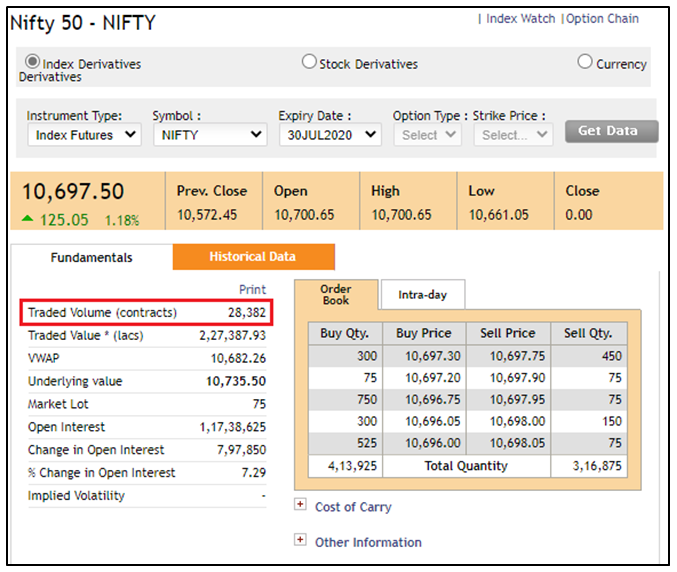

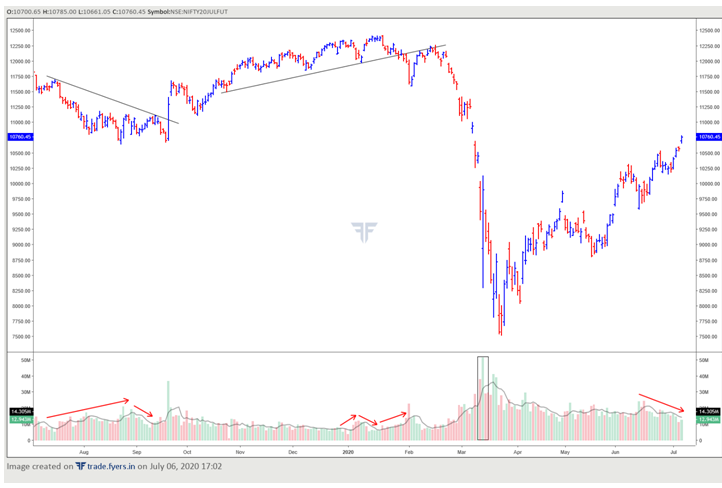
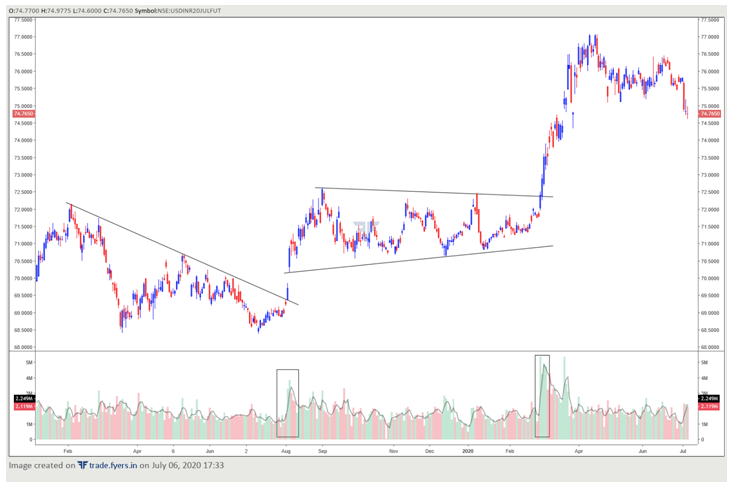
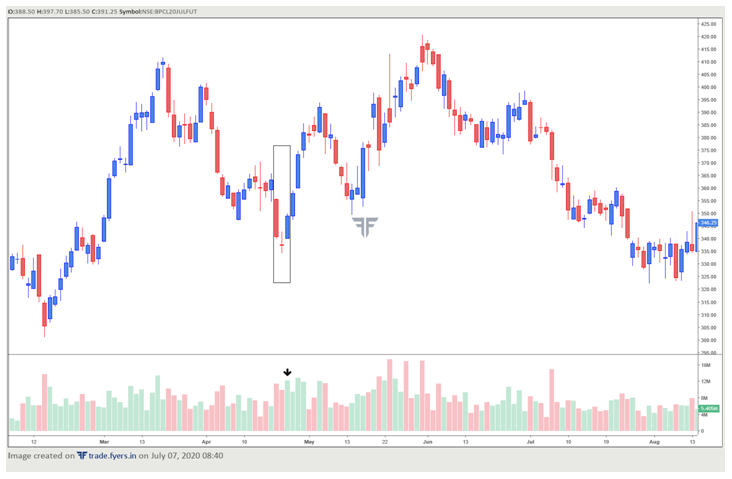
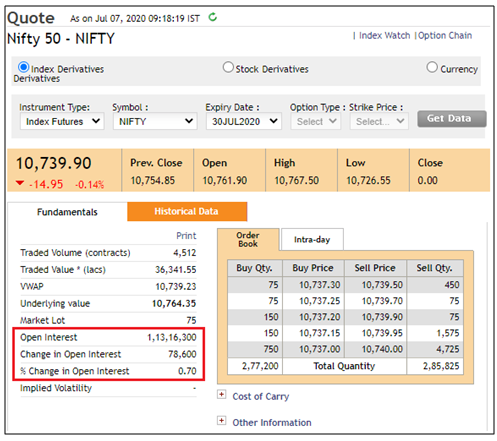
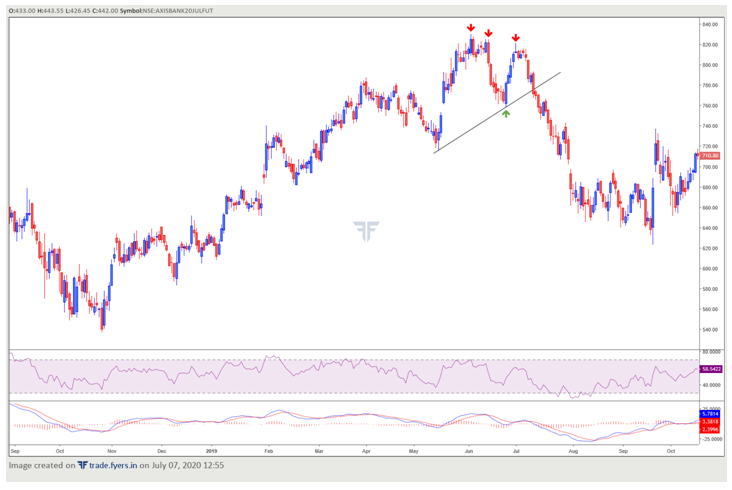
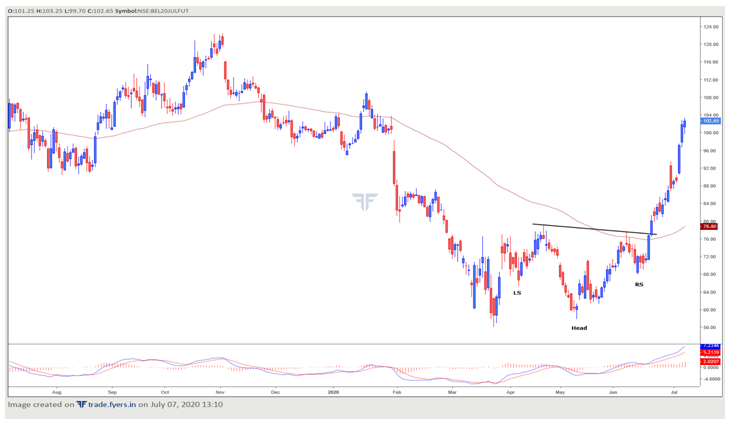

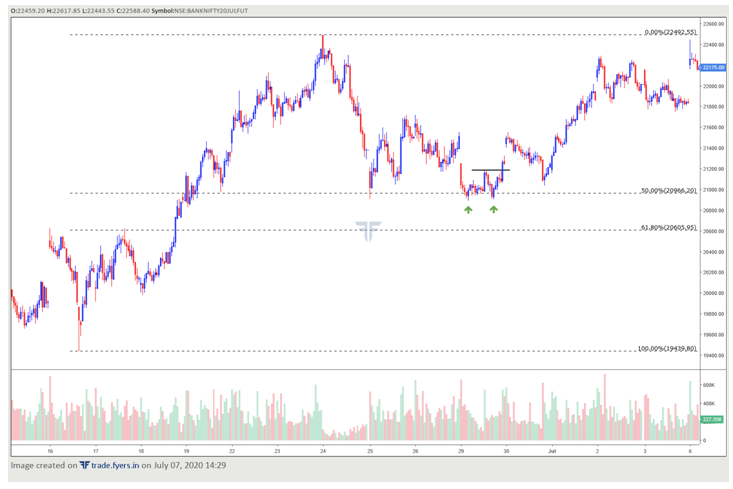
Vijay commented on July 29th, 2020 at 10:52 PM
Nice explanation
Abhishek Chinchalkar commented on July 31st, 2020 at 8:16 AM
Hi Vijay, thank you for the valuable feedback!
Sushil Kumar commented on July 30th, 2020 at 2:17 PM
Nicely explained.. Expecting such valuable information in future as well.
Abhishek Chinchalkar commented on July 31st, 2020 at 8:18 AM
Hi Sushil, thank you for the valuable feedback! Be rest assured that we will come out with more of such quality content in future.
Mayur commented on September 6th, 2020 at 1:17 PM
Sir
Mujhe fyear main a/c open karana hai.mujhe kya other benefits milenge pls reply